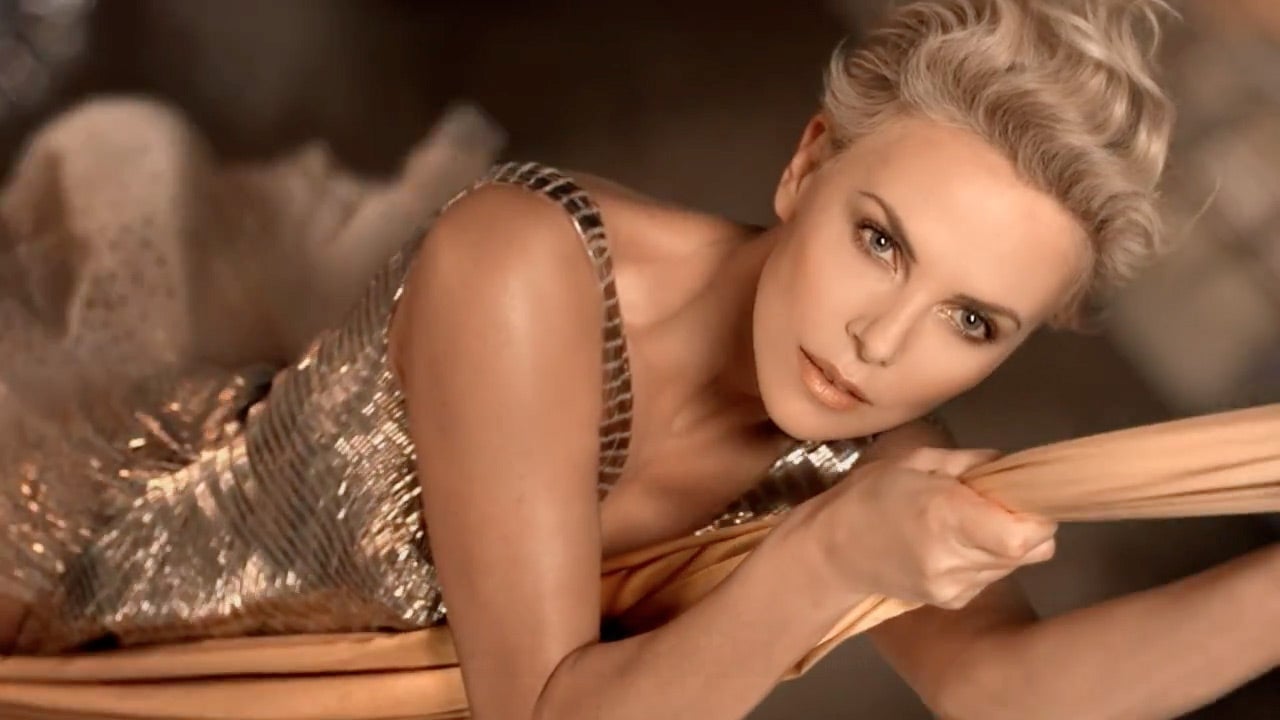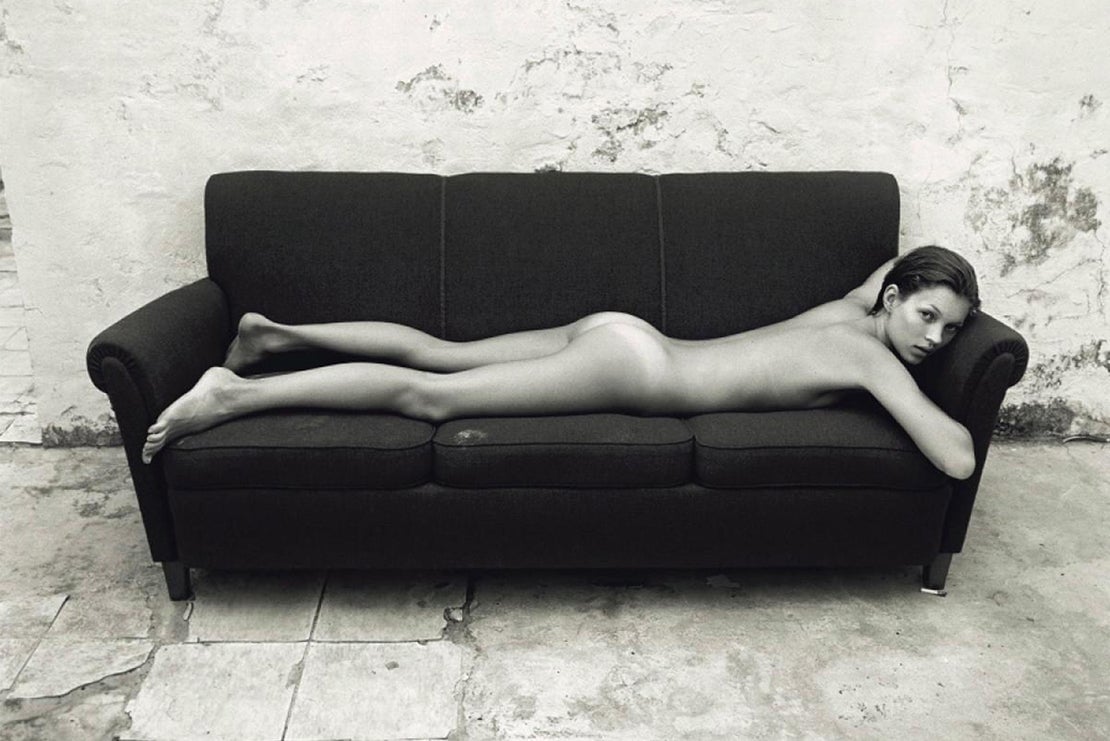Why are celebrity perfume commercials so incredibly awful?
It starts with a woman. She’s beautiful, and wears an exquisite shimmering gold dress. As she walks forward, musing about history, a length of satin falls from the ceiling. She begins climbing it with an expression of ecstasy. Near the top, she pauses to rip off a necklace of golden pearls, then emerges on the building’s roof.


It starts with a woman. She’s beautiful, and wears an exquisite shimmering gold dress. As she walks forward, musing about history, a length of satin falls from the ceiling. She begins climbing it with an expression of ecstasy. Near the top, she pauses to rip off a necklace of golden pearls, then emerges on the building’s roof.
“J’adore, Dior,” she says. We see a bottle of perfume.
Huh?
“Don’t overthink it,” advises Adweek.
The commercial is Dior’s “The Future is Gold,” starring Charlize Theron, to promote its perfume J’adore. The dream-like plot, heavy-handed-yet-vague symbology, and confusing, pseudo-profound monologue are familiar—the basic, nonsensical ingredients of any fragrance commercial.
These ads, usually featuring mega-celebrities, cost millions of dollars to produce. The brands behind them are considered taste leaders in their industries, and enlist star directors from Martin Scorcese to Baz Luhrmann. So why are perfume ads so bafflingly weird? There are actually several perfectly logical reasons.
Perfume doesn’t do anything…
Most commercials show people happily using the product, to successful effect: a shiny-clean floor, lusciously curled hair, the envious gaze upon an imposing new car. But how do you show the effect of perfume?
“A fragrance doesn’t do anything,” said Robert Green, vice president of advertising for Calvin Klein Cosmetics, in a 1991 interview with the New York Times. ”It doesn’t stop wetness. It doesn’t unclog your drain.”
That uselessness is a challenge for marketers. If you can’t show what a product does, you have to find another way to sell it. And playing to feelings is often your best bet.
…but it taps into our emotional centers
Scents have one advantage in that regard. Our sense of smell is strongly tied to our emotions and sexual desires. Smells are inherently neutral to us, but we can create deep emotional connections to various smells.
The brain’s emotion-processing amygdala, as well as parts that deal with memory and motivation, actually grew out of our olfactory cortex, explains Rachel Herz, an expert on the psychology of smell, in her book, The Scent of Desire. “No other sensory system has this kind of privileged and direct access to the part of brain that controls our emotions,” she writes.
To highlight that connection, advertisers emphasize the emotional power of scent, especially when it comes to sex.
Scent always comes down to sex
The link between scent and desire turns up in texts as old as the Hindu Kama Sutra, which says the sweat of the perfect woman “has the odor of musk,” and in the Hebrew Song of Songs, where King Solomon and his bride confess their love for each other. “Pleasing is the fragrance of your perfumes; / your name is like perfume poured out,” Solomon says.
No single scent can predictably attract another person, according to Herz. Even pheromone perfumes, which supposedly use arousing biological ingredients, haven’t been proven to work.
But that hasn’t stopped advertisers from playing up the connection. “At least from the ’40s, and probably before that, erotic themes, subtle or less so, have been used to sell fragrance,” Tom Reichert, author of The Erotic History of Advertising, tells Quartz.
“To create a fantasy for the consumer is what fragrance is about,” Green also told the New York Times in his interview. “And sex and romance are a big part of where people’s fantasies tend to run.” Shortly after, Calvin Klein kicked off years of notoriously salacious advertising, featuring model Kate Moss.

Perfume ads speak to your subconscious in its own weird language
Commercials rely on the power of suggestion. In pizza advertising, for example, the “cheese pull” is the moment when the single slice of pizza pulls away and strands of gooey, melted cheese seductively stretch behind it. It’s a visual metaphor for the taste and feel of pizza.
“In perfume advertising, the equivalent of the ‘cheese pull’ is the heavy eyelid, which suggests sexual satisfaction,” says advertising veteran Josh Weltman, who was a co-producer of Mad Men and wrote the book Seducing Strangers: How to Get People to Buy What You’re Selling. Note Charlize Theron’s weighted lids in the Dior ad. This look, he says, is one of the most cliched images in fragrance ads.
Unlike racy print advertising in magazines, TV commercials can’t get too graphic without quickly running afoul of standards boards. In 2013, a relatively tame Chanel ad with Keira Knightley was banned by the Advertising Standards Authority from being broadcast anywhere near children’s programming for being too sexually suggestive.
So most ads have made an art of saying things without really saying them. The standard was set by Chanel’s watershed 1979 “Share the fantasy” spot, directed by Ridley Scott, who also released Alien that year.
The commercial, according to The Erotic History of Advertising, was different because of what it didn’t show. ”The spot’s lack of carnality and blatant sexual referents diverged from other fragrance advertising at the time,” Reichert writes. He quotes brand researcher William Baue, who noted, “Focusing on fantasy allowed Chanel to harness the power of sexuality without crossing the border into distaste.” It was dirty, even as it kept Chanel clean.
Loaded with surreal imagery, such as a manicured park turning into piano keys, it forced viewers to infer what it was getting at through suggestive images, including a vaguely phallic shot of a building fading into one of a woman’s face as she closes her eyes in what appears to be pleasure. It was the sort of psychosexual dream narrative we continue to see today.
Decades later, the ad still resonates. It was the only perfume campaign to make Ad Age‘s list of the 100 best advertising campaigns of the 20th century.
Perfume ads use the same tricks as Doritos ads
Weltman describes many perfume ads as ”some art director’s interpretation of the Jungian archetypical dream” for the specific woman the advertiser is trying to reach. (Chanel and Dior declined to comment for this story.)
In addition to sex, recurring themes include freedom, beauty, romance, and distinction. Weltman says those qualities weren’t selected randomly. “I guarantee you, someone has done a lot of focus groups and had the target audience talk to them a lot about what their dream is, what their ultimate fantasy is,” he says. “You try to backwards engineer a dream that it looks like any of them could have had.”
Women, in particular, are often portrayed breaking free of some restraint, a motif Weltman likens to a similar mechanism in ads for junk food.
“We found the same thing with Doritos advertising: There’s a certain group of women in this target market who need permission to indulge,” he says. “It’s basically choosing to unlock your own handcuffs. You’re repressing yourself if you deny yourself this pleasure.”
Maybe they’re trolling us
These factors have combined to create an advertising genre so notorious for its nonsensical stylings that the perfume-commercial parody has become a genre in itself.
After the success of Scott’s fragmented narrative and psychosexual symbolism, commercials just seemed to get stranger. Calvin Klein’s 1987 commercial for its scent, Obsession, is even odder and funnier than Saturday Night Live’s famous parody of it (which renamed the scent “Compulsion,” and depicted a woman obsessed with cleanliness). Below is the original ad—not a parody:
Today, fragrance ads practically beg to be made fun of. ”I’ve done quite a few ads that have been parodied, and you always know you’ve really got it made when that happens,” Glenn O’Brien, who penned the script for Brad Pitt’s widely ridiculed Chanel No. 5 ad, told New York magazine in 2012.
By his own admission, O’Brien, a respected men’s fashion writer, is responsible for a number of commercials that have been called out for their absurdity. “I did this campaign for Calvin Klein with Steven Meisel years ago that was considered to be very risqué, and President Clinton spoke out against it, but then we were parodied by Beavis and Butt-Head,” he recalled. “And to me, that was the highest compliment.”
With each new ad, for women’s scents or men’s, nonsense remains central to the fantasy.
Do the creators even know they’re weird?
Even if the conditions are ideal for fragrance ads to indulge in fantasy, it takes a creative director to make them bizarre. ”Whoever’s calling the creative shots, they think that these ads are beautiful and stylistic and all those things they want the brand to represent,” Reichert tells Quartz. “But they operate in a whole different world than the rest of us, stylistically and aesthetically.”
It was John Galliano, Dior’s former design head and a designer who previously created a “homeless” couture collection, who oversaw the “J’adore Dior” ads with Charlize Theron. Elizabeth Musmanno, who is president of The Fragrance Foundation, a non-profit representing fragrance companies, knows because she was Dior Couture’s PR director at the time. ”He was the creative director for the fashion house, the windows, the advertisements,” she tells Quartz. “He did those commercials with Charlize that Jean Baptiste Mondino shot.”
The notion of the bizarre perfume ad, made by a creative director disconnected from the rest of the world, has become ingrained in pop culture. One of the funniest depictions is a scene in the 1992 movie Boomerang with Eddie Murphy, where an agency pitches an ad for a scent called Strangé.
The strangest thing is that they seem work
Perfume commercials aren’t just selling fantasy—or, for that matter, perfume. They’re selling an entire brand, and fragrances are an important entry point. ”I may not be able to afford a $3,000 Chanel bag,” Musmanno says. “But I could aspire to buying the fragrance, and still have a piece of Chanel.”
For fashion houses in particular, scents are a high-margin item compared to clothing. And while runway shows may garner all the media attention, fragrances substantially help the bottom line by reaching a much broader range of customers than pricey couture. It’s no surprise more brands keep entering the market.
TV commercials allow these brands to reach a mass audience. According to iSpot.tv, a TV-advertising analytics service, the TV shows targeted most by fragrance advertisers in the US in 2015 were Keeping up with the Kardashians, The Big Bang Theory, and Modern Family—all shows with mass viewerships.
Most of the ads were for women’s fragrances, and iSpot calculated that brands occupied tens of millions worth of TV air time plugging them. Chanel’s top fragrance ads racked up about $36 million in air-time value. (The figures not necessarily what the brands paid, just what the time was valued at.) Interestingly, the ad with the highest cumulative value of air time—$14 million—was for Bleu de Chanel, a men’s fragrance.
Musmanno says a good ad can’t make up for a bad scent, but they create awareness and curiosity. Fragrance sales, meanwhile, keep rising.
But still, it’s time for a change
On occasion, a new perfume ad will stir excitement, as Calvin Klein’s ads did in the 1990s. But as weird ad after weirder ad keeps coming, it’s debatable whether each is successfully distinguishing its product in the market, or just dropping another vaguely French perfume name into a sea of strangeness.
“I think there’s room for a new voice, to be honest,” Musmanno says. “There’s room for a disruptor.”
Now that makes sense.